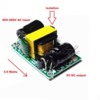It's clearly not that difficult to produce a digital meter that would fit our needs, that's not the issue. That has been discussed here several times. The issue is what it would cost to bring such a product to the table and still make it worthwhile for the builder. The easy part is actually designing the meter, and even designing and laying out the circuit board for the product is no sweat. I have a few products that I produce that I've done all of those steps for. Consider the Super-Chuffer, Chuff-Generator, LED Lighting Regulator, and the YLB - RailSounds Battery Replacement.
Now, let's get to the harder parts. The injection molded case for the meter, just the tooling will bury you. Next is the cost of components and assembly. I can tell you with certainty that it's not as cheap as you might imagine building stuff in the quantities required for a limited market, and that comes from experience with my little suite of products. My biggest issue is trying to actually do all the steps of producing them from the design through the manufacturing and packaging and still bring them to market with a price that makes sense. Some will say I miss the mark at times, that's the realities of life. The eBay meters have set the bar very low as far as pricing, $5-6 won't even buy the components at the pricing I can get for small quantities (100-200).
I have deliberately steered clear of having to create custom casework for a product as just looking into the startup costs convinces me that I'd never get my investment back.
Dave Zucal posted:TedD, all we need is for the price to be more admirable for purchasing the RRampMeter meter. This meter is a great and accurate meter, just very expensive.
I rest my case, that's about the price I'd end up with if I had to supply custom packaging for the product. ![]()






















